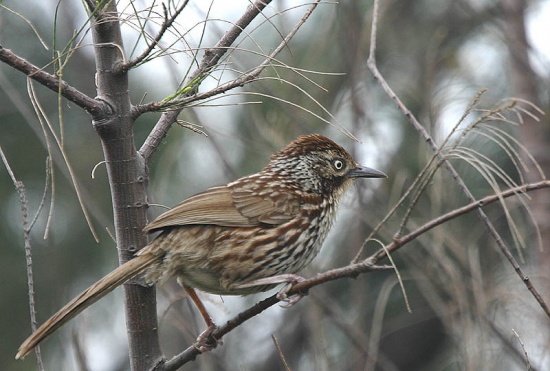Alternative names: Common Babax; Streaked Hill-Babbler
- Pterorhinus lanceolatus
Garrulax lanceolatus
Ianthocincla lanceolatus
Identification
22.5 - 29.5 cm (8¾-11½ in).
Speckled darkish brown upperparts, buffer speckled underparts, brownish cap, long tail, grey bill, white iris, grey legs and feet.
Juveniles are buffier overall than adults.
Distribution
Found mainly in south and central China but also in Myanmar. Population in Hong Kong of captive origin. Common in most of its range, status in India unclear and no recent published records.
Taxonomy
Clements now places this species in the genus Ianthocincla, Gill and Donsker in Pterorhinus.
Subspecies
Three subspecies recognized[1]:
- P. l. bonvaloti in southern China (southeastern Xizang to west central Sichuan and northwestern Yunnan)
- G. l. lanceolatus in central and southern China (from southern Gansu, southern Shaanxi, and western Hubei south to central and northern Yunnan, central and eastern Sichuan and northern Guizhou) and northeastern and central Myanmar
- P. l. latouchei in southeast China (Guizhou, Guangxi, Guangdong and Fujian)
Mount Victoria Babax (Pterorhinus woodi) was recently split from Chinese Babax.
Habitat
Wide variety of habitats from open broadleaf forest to forest edge, secondary growth, more open hillside covered with bracken, scrub and grass, bamboo or tea plantations.
Behaviour
Diet
Feeds on insects and seeds.
A shy bird, usually foraging on or near the ground, sometimes in trees.
Breeding
Breeding season from March to August. The nest is a cup made of fir, dead bamboo and other leaves. It's placed about 1m above the ground in a low thorn or other bush. Lays 2 - 6 eggs.
Movements
Resident species.
References
- Clements, J. F., T. S. Schulenberg, M. J. Iliff, S. M. Billerman, T. A. Fredericks, B. L. Sullivan, and C. L. Wood. 2019. The eBird/Clements Checklist of Birds of the World: v2019. Downloaded from http://www.birds.cornell.edu/clementschecklist/download/
- Gill F, D Donsker & P Rasmussen (Eds). 2020. IOC World Bird List (v10.1). doi : 10.14344/IOC.ML.10.1. Available at http://www.worldbirdnames.org/
- Del Hoyo, J, A Elliott, and D Christie, eds. 2007. Handbook of the Birds of the World. Volume 12: Picathartes to Tits and Chickadees. Barcelona: Lynx Edicions. ISBN 978-8496553422
Recommended Citation
- BirdForum Opus contributors. (2024) Chinese Babax. In: BirdForum, the forum for wild birds and birding. Retrieved 29 April 2024 from https://www.birdforum.net/opus/Chinese_Babax




